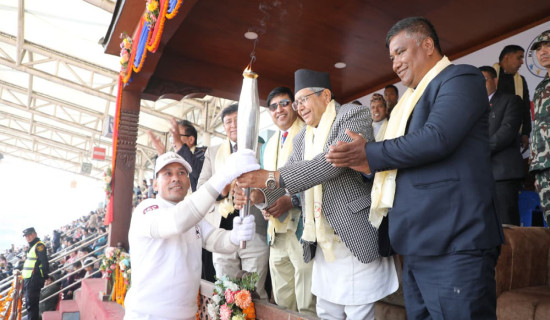- Sunday, 28 December 2025
Open Prison Concept Materialises
August 31, 2024 has become a historic day in Nepal. On this day, the open prison in Nuwakot, the first of its kind in Nepal, was inaugurated by Home Minister Ramesh Lekhak by relocating 147 inmates from the Nuwakot prison to the open prison built at Khampa Camp of the same district. The concept of the open prison is encapsulated in the Criminal Offences (Sentencing and Execution) Act, 2017. After eight years since the Act came into force, the concept has materialised, which can be considered a milestone in prison management in Nepal.
The provision of open prisons exists in many countries. Our neighbouring country India has several open prisons. The Tihar Jail is among them. Likewise, the United Kingdom, Indonesia, the Philippines, Germany and other countries also have the system of open prisons. Under the concept of the open prison, prisoners are allowed to go outside the places of detention and work for a certain period of time with minimum supervision and control under the prescribed terms and conditions. The period of work is deducted from the prison term. In case the terms and condition are infringed upon during the period of work, the prisoners are sent back to traditional prisons to serve the remaining sentence, or a fresh sentence may be imposed on them.
Relocation
In Nepal’s context, the provision of open prisons is mentioned in Article 28 of the above-mentioned Act. The provisions are similar to those stated above. As per the Act, the judge of the district court concerned, on the recommendation of the chief of the prison office, may issue an order to relocate inmates from traditional prisons to open prisons. Not all inmates will be relocated to open prisons. Those inmates who have completed at least two-thirds of their sentence and who have a track record of good conduct will be relocated to open prisons. Those inmates whose full court verdict is yet to come out, who are in pre-trial detention or who are unable to post bail are not eligible for relocation to open prisons. Further, the inmates serving short sentences will not be eligible, either.
The inmates in open prisons are allowed to leave the prisons and go out to work because such prisons provide work opportunities. However, the inmates have to abide by the specified terms and conditions. If they fail to follow the terms and conditions, or commit any offence punishable by the law, they must serve the whole period of imprisonment.
The concept of the open prison is to reduce overcrowding in prisons. In Nepal, there are around 28,700 prisoners locked up in 75 prisons in 72 out of 77 districts. Most of the prisons are overcrowded. Some of the prison buildings are also dilapidated, compromising the safety of the prisoners.
Open prisons are a luxury vis-à-vis traditional prisons. In tradition prisons, inmates are kept in prison cells, where they are forced to lead a confined life. In contrast, open prisons provide more freedom of movement. Inmates are not often kept in prison cells as in traditional prisons. They are trusted and allowed to go outside the places of detention to work. They are under minimum supervision, control and perimeter security. In fact, the concept of the open prison emphasises rehabilitation rather than punishment, thus facilitating social reintegration. There are voices for respecting human rights of everyone in the world. Even prisoners have human rights, which must be respected. So the concept of the open prison may be taken as a challenge to the traditional concept of incarceration.
Open prisons function on the edifice of trust. So those prisoners who are a potential threat to society should not be locked up there. Prisoners who have committed heinous crimes such as rape, murder, bank heist, arson, hostage-taking, drug trafficking, human trafficking, enforced disappearance of people and the like should be kept in traditional prisons. So only those prisoners who have committed minor offences as defined by the law should be kept in open prisons.
As per the study titled "Open Prisons and Recidivism", open prisons work towards potentially reducing the rate of recidivism. The ambience in open prisons plays a catalytic role in improving not only the behaviour but also the mental health of prisoners. Prisoners can enjoy a positive lifestyle as they do not have to undergo the stress they would have to go through in traditional prisons. With positive vibes available in open prisons, the possibility of them turning recidivist dwindles. After serving their sentence, they can become useful members of society.
Reformatory
Open prisons are a kind of reformatory where prisoners are given an opportunity to reform themselves by shunning criminal behaviour. In our society, people have a negative attitude towards both criminals and ex-criminals. Society should also change its attitude and welcome those who have shunned their criminal behaviour and who want to lead a normal life. However, there are some who are repeated offenders. The law should come down heavily on such people; they are a danger to society. In a sense, they are the scum of society as they contribute nothing to society.
As stated above, open prisons are a luxury. In Nepal, there are certain criteria for the relocation of prisoners from traditional to open prisons. The criteria should be strictly followed. Political leaders, top bureaucrats and other influential people may press the government to transfer their relatives, friends or favourites to the Nuwakot open prison. There are also political leaders, people’s representatives, civil servants and other influential people in prisons. Such high-profile people may exert pressure on the government to get relocated to the open prison. So the government should ensure that the criteria for imprisonment in open prisons are strictly followed.
(Maharjan has been regularly writing on contemporary issues for this daily since 2000.)

















